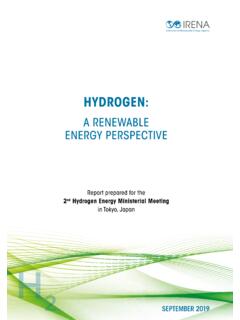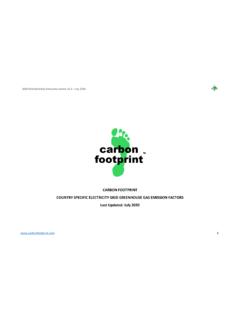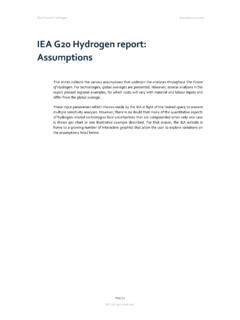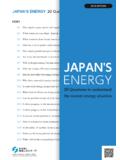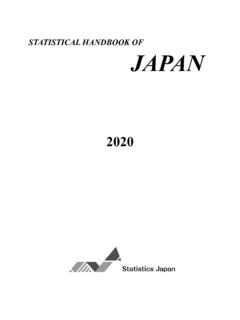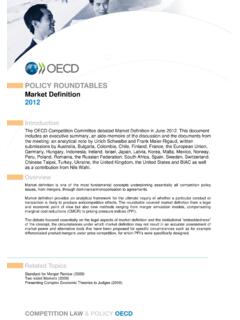Transcription of Iran Sanctions - FAS
1 Iran Sanctions Updated April 6, 2021 Congressional Research Service RS20871 Congressional Research Service SUMMARY Iran Sanctions Successive Administrations and Congresses have used economic Sanctions to try to change Iran s behavior. Sanctions on Iran primarily secondary Sanctions on firms that conduct certain transactions with Iran have adversely affected Iran s economy but have arguably not, to date, altered Iran s pursuit of core strategic objectives including its support for regional armed factions and its development of missiles. Sanctions did contribute to Iran s decision to enter into a 2015 agreement that put limits on its nuclear program the Joint Comprehensive Plan of Action (JCPOA). During 2011-2015, in implementation of deliberate policy, global economic Sanctions contributed to the shrinking of Iran s economy as its crude oil exports fell by more than 50% and it could not access its foreign exchange assets abroad.
2 Upon Iran s implementation of nuclear program restrictions stipulated by the JCPOA, the Obama Administration eased the relevant Sanctions and and European Union Sanctions were lifted as well. Remaining in place were Sanctions on direct trade with Iran and on Iran s support for regional armed factions, its human rights abuses, and on its efforts to acquire missile and advanced conventional weapons technology. Security Council Resolution 2231, which endorsed the JCPOA, kept in place an existing ban on its importation or exportation of arms (which expired on October 18, 2020) and a nonbinding restriction on Iran s development of nuclear-capable ballistic missiles (until October 18, 2023). The Sanctions relief enabled Iran s economy to return to growth and allowed Iran to order some new passenger aircraft.
3 On May 8, 2018, President Trump ended participation in the JCPOA and reimposed all secondary Sanctions by November 6, 2018. The reimposed Sanctions , and additional Sanctions imposed subsequently, were at the core of Trump Administration policy to apply maximum pressure on Iran, with the stated purpose of compelling Iran to negotiate a revised JCPOA that takes into account concerns beyond Iran s nuclear program. The policy caused Iran s economy to fall into significant recession as a result, in part, of reduced sales of oil and isolation from the international financial system. The Trump Administration also sanctioned several senior Iranian officials as well as figures in regional pro-Iranian factions and militias. Yet, Iran continued to develop its missile capabilities and to provide arms and support to a broad array of armed factions operating throughout the region, while refusing to begin talks with the United States on a more expansive, revised JCPOA.
4 The European Union and other countries have sought, unsuccessfully, to keep the economic benefits of the JCPOA flowing to Iran in order to persuade Iran to remain in the nuclear accord. Since mid-2019, Iran has responded to the increasing Sanctions by decreasing its compliance with the nuclear commitments of the JCPOA and by conducting provocations in the Persian Gulf and in Iraq. Since taking office, President Joseph Biden has sought to implement a stated intent to rejoin the JCPOA, including welcoming talks with Iran toward that end. Administration officials have acknowledged that a return to the agreement would entail an easing of the stipulated economic Sanctions . See also CRS Report R43333, Iran Nuclear Agreement and Exit, by Paul K. Kerr and Kenneth Katzman; and CRS Report R43311, Iran: Economic Sanctions and the Authority to Lift Restrictions, by Dianne E.
5 Rennack. RS20871 April 6, 2021 Kenneth Katzman Specialist in Middle Eastern Affairs Iran Sanctions Congressional Research Service Contents Overview .. 1 Blocked Iranian Property and Assets .. 1 Executive Order 13599 Impounding Iran-Owned Assets .. 3 Sanctions for Iran s Support for Armed Factions .. 3 Sanctions Triggered by Terrorism List Designation .. 3 Exception for Humanitarian Aid .. 5 Sanctions on States Not Cooperating Against Terrorism .. 5 Executive Order 13224 Sanctioning Terrorism-Supporting Entities .. 5 Implementation of 13224 .. 5 Foreign Terrorist Organization (FTO) Designations .. 6 Other Sanctions on Iran s Support for Regional Armed Factions .. 6 Executive Order 13438 on Threats to Iraq s Stability .. 6 Executive Order 13572 on Repression of the Syrian People.
6 6 Hezbollah-Specific Financial Sanctions .. 7 Ban on Trade and Investment with Iran .. 7 What Trade Is Allowed or Prohibited? .. 8 Application to Foreign Subsidiaries of Firms .. 10 Sanctions on Iran s Energy Sector .. 10 The Iran Sanctions Act .. 11 Key Sanctions Triggers Under ISA .. 11 Mandate and Time Frame to Investigate ISA Violations .. 14 Interpretations of ISA and Related Laws .. 15 Implementation of Energy-Related Iran Sanctions .. 16 Oil Export Sanctions : FY2012 NDAA Sanctioning the Central Bank .. 17 Implementation/SREs Issued and Ended .. 18 Waiver and Termination .. 19 Iranian Foreign Exchange Accounts Restricted .. 19 Sanctions on Arms and Weapons-Related Technology Transfers .. 20 Iran-Iraq Arms Nonproliferation Act and Iraq Sanctions Act .. 21 Banning Aid to Countries that Aid or Arm Terrorism List States: Anti-Terrorism and Effective Death Penalty Act of 1996.
7 21 Proliferation-Related Provision of the Iran Sanctions Act .. 22 Iran-North Korea-Syria Nonproliferation Act .. 22 Executive Order 13382 on Proliferation-Supporting Entities .. 22 Arms Transfer and Missile Sanctions : The Countering America s Adversaries through Sanctions Act (CAATSA, 115-44) .. 23 Executive Order 13949 on Sales of Arms (September 21, 2020) .. 23 Foreign Aid Restrictions for Named Suppliers of 24 Sanctions on Countries of Diversion Concern .. 24 Financial/Banking Sanctions .. 25 Targeted Financial Measures .. 26 Ban on Iranian Access to the Financial System/Use of Dollars .. 26 Punishments/Fines Implemented against Some Banks.. 26 CISADA: Sanctioning Foreign Banks That Conduct Transactions with Sanctioned Iranian Entities .. 27 Iran Sanctions Congressional Research Service Implementation.
8 28 Waiver and Termination .. 28 Iran Designated a Money-Laundering Jurisdiction .. 28 Financial Action Task Force (FATF) .. 29 SWIFT Electronic Payments System .. 29 Sanctions on Iran s Non-Oil Industries and Sectors .. 29 The Iran Freedom and Counter-Proliferation Act (IFCA) .. 30 Implementation .. 31 Waiver and Termination .. 31 Executive Order 13645/13846: Iran s Automotive Sector, Rial Trading, and Precious Stones .. 31 Executive Order 13871 on Iran s Minerals and Metals Sectors .. 31 Executive Order 13902 on the Construction, Mining, Manufacturing, and Textiles Sector (January 10, 2020) .. 32 Executive Order 13608 on Sanctions Evasion .. 32 Sanctions on Cyber and Criminal Activities .. 33 Executive Order 13581 .. 33 Executive Order 13694 .. 33 State-Level Sanctions .. 33 Sanctions Supporting Democracy/Human Rights.
9 33 Expanding Internet and Communications Freedoms .. 34 Measures to Sanction Human Rights Abuses/Promote Civil Society .. 35 Non-Iran Specific Human Rights Laws .. 36 Sanctions on Iran s Leadership .. 36 Executive Order 13876 .. 37 Sanctions .. 37 Resolution 2231 and Sanctions Eased .. 37 Sanctions Application under Nuclear Agreements .. 39 Sanctions Eased by the JPoA .. 39 Sanctions Easing under the JCPOA and Reimposition .. 39 Sanctions that Remained in Place under the JCPOA .. 40 Sanctions Imposed Subsequent to the Exit from the JCPOA .. 41 International Implementation and Compliance .. 42 European Union (EU) .. 43 European Special Purpose Vehicle/INSTEX .. 44 SWIFT Electronic Payments System .. 44 China and Russia .. 45 Japan/Korean Peninsula/Other East Asian Countries .. 46 Other East Asian Countries.
10 46 India and Pakistan .. 46 Turkey .. 47 Iraq and Persian Gulf States .. 47 Syria and Lebanon .. 48 Venezuela .. 49 International Financial Institutions/World Bank/IMF and WTO .. 49 WTO Accession .. 49 Effectiveness of Sanctions .. 50 Iran Sanctions Congressional Research Service Effect on Iran s Nuclear Program and Strategic Capabilities .. 50 Effects on Iran s Regional Influence .. 50 Iranian Domestic Political Effects .. 51 Economic Effects .. 52 Iran s Economic Coping Strategies .. 53 Effect on Energy Sector Development .. 54 Human Rights-Related Effects .. 55 Humanitarian 55 COVID Response .. 55 Air Safety .. 56 Post-JCPOA Sanctions Legislation .. 56 114th Congress .. 56 Iran Nuclear Agreement Review Act ( 114-17) .. 57 Visa Restriction .. 57 Iran Sanctions Act Extension .. 57 Reporting Requirement on Iran Missile Launches.










